FORMER HAIDA WEAPONS, SMALL ARMS & MISC

The weapons featured below were originally fitted on HAIDA
in 1943 but nearly all were removed during the ship's mid-life modernization
of 1949-1952. Most specifications were referenced from the book "Battle
Ensign Flying" . Although the Iillumination Rockets and Very pistols
are not weapons, they are shown here because its convenient.
Uses: Against surface targets and aircraft flying
at low altitude.
Description: Six, quick firing, 4.7 inch Mk XII guns mounted
on a Mk XIX power mount. These guns were mounted at the A, B and Y positions.
Maximum elevation and depression: +40 to -10 degrees. The long
ammunition tray limited the elevation of the barrels so this gun was not
suitable for bringing down high flying aircraft.
Maximum training arc: 320 degrees.
Rate of fire per minute per gun: 12 rounds maximum with power ramming.
Projectile weight: 50 pounds
Cartridge weight: Normally 32 pounds, 10 oz.
Maximum surface range: 16,900 yards.
Maximum vertical height: 15,000 feet.
Projectile types: Semi armor piercing and starshell.
Fuse types: Base percussion, direct action, time mechanical or variable
time for A/A barrage.
Comment: The 4.7 inch guns at 'A' and 'B' positions were replaced
with a 4 inch gun, At X position, a 3 in 50 was the replacement.Nothing
replaced the gun at 'Y' position.
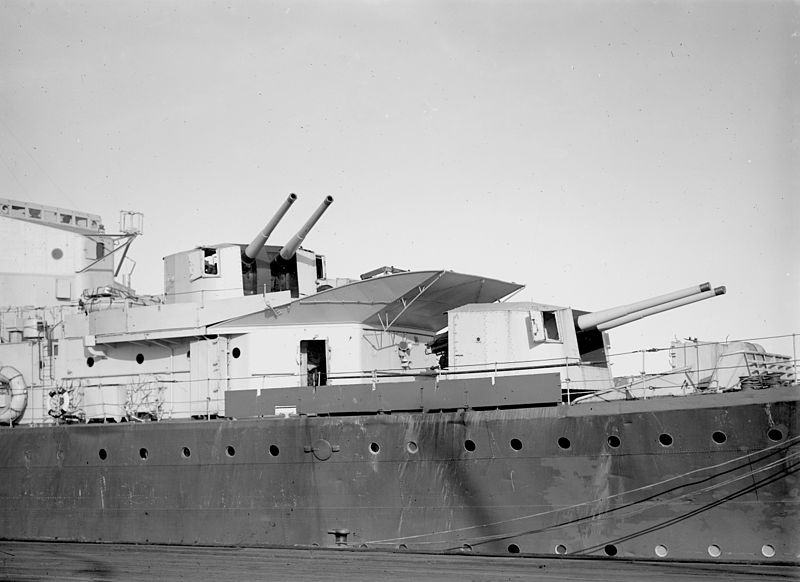 |
| 4.7 inch guns at A, B and Y positions.
(Photo
by Allan C. Green) |
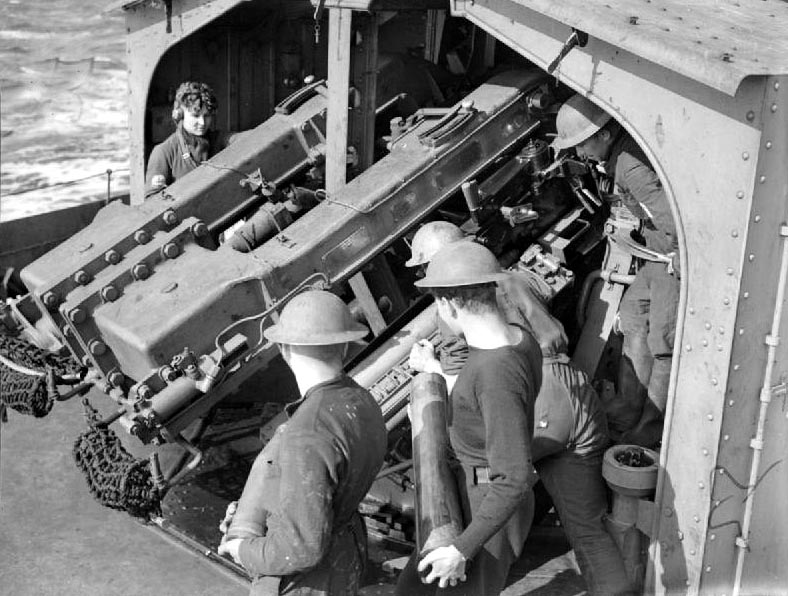 |
| Rear view of the 4.7 inch Mk XII gun . (Photo
#A291 by Coote, R G G (Lt), Royal Navy official photographer) |
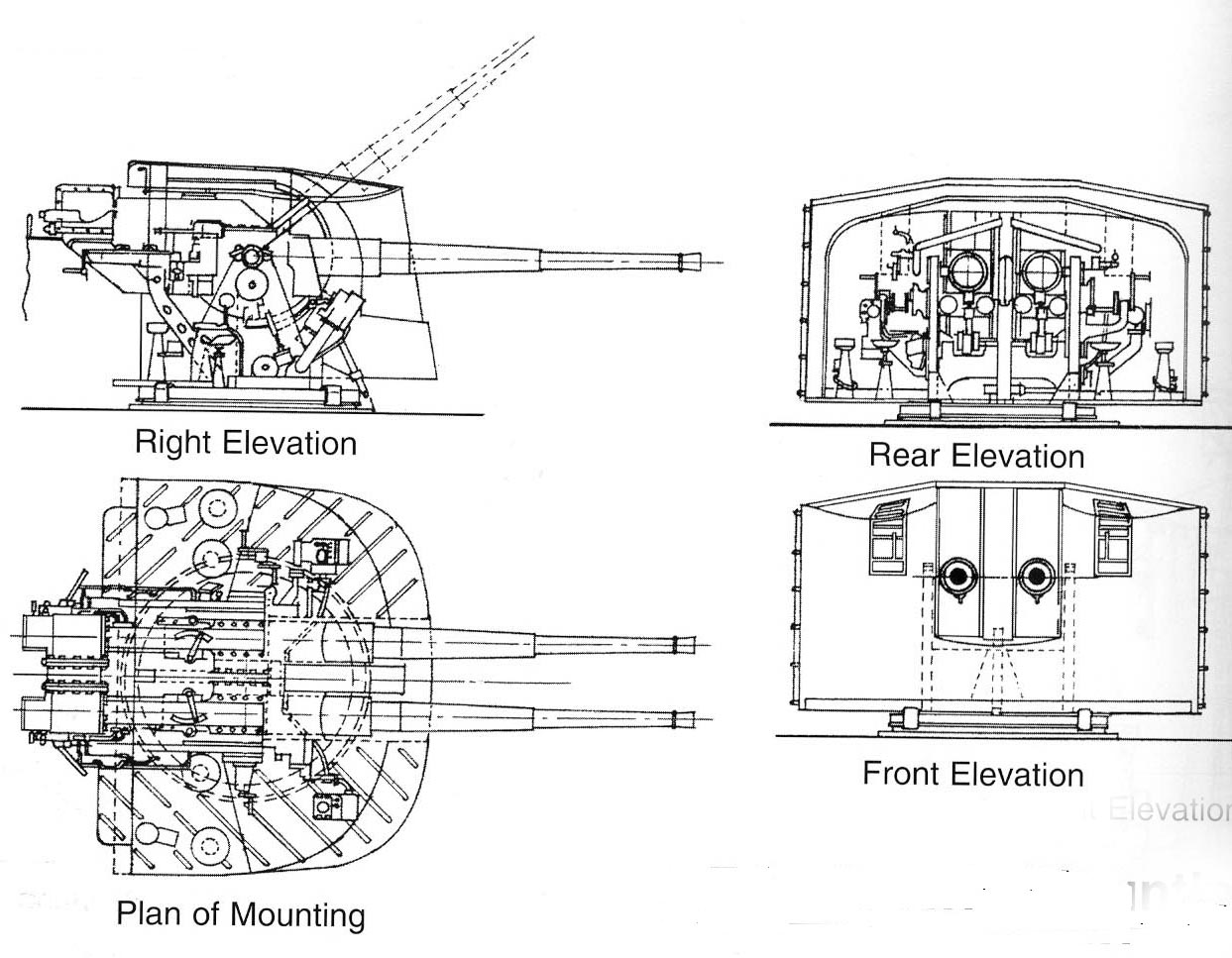 |
| 4.7 inch gun pictorial. Click on image
to enlarge. (Battle Ensign Flying) |
Use: Close range armament.
Description: Four, quick firing, (1 x 4), 2 pounder,
Mk VIII guns fitted to a Mk VII (P) platform. above and forward of the
'X" gun position.
Maximum elevation and depression: +80 and -10 degrees.
Rate of fire per minute per gun: 115 rounds
Ammunition feed: Continuous - belt
Shell weight: 2 pounds
Maximum surface range: 5,000 yards.
Maximum vertical height: 10,000 feet
Comment: Replaced with 40 mm Bofors.
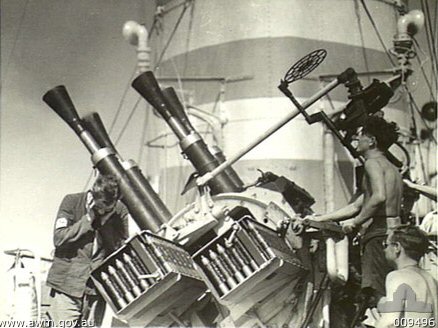 |
| 2 pounder about to fire. (Photo
by George Silk) |
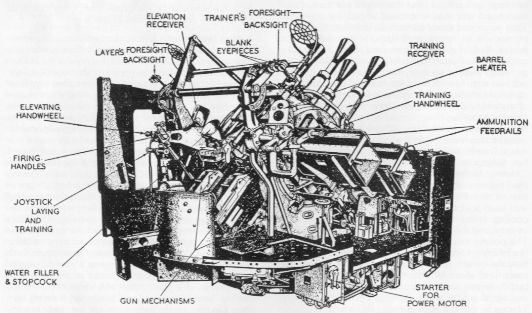 |
| 2 pounder pictorial from BR 224/45. |
HAIDA carried six, twin, Mk IV, Oerlikons (6 x2)
on Mk VC power mounts for use as an anti aircraft weapon . That's a total
of 12 barrels. Two mounts were on the flag deck, both port and starboard
sides. The two others were amidships (port and starboard) on the
after superstructure.
(Maximum elevation and depression: +70 to -10 degrees.
Maximum training rate: Continuous, all around.
Rate of fire per gun: 480 rounds/minute
Total rounds available: 7,200 between the 12 barrels. (120 magazine's
worth)
Magazine capacity: 60 rounds per gun
Maximum surface range: 6,000 yards
Maximum vertical height: 6,000 feet.
Shell type: H.E. incendiary
Comment: Replaced by 40 mm Bofors.
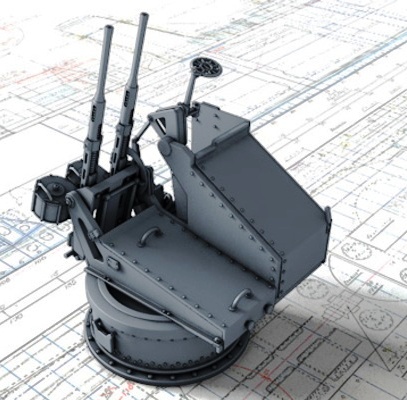 |
| This digital image of an Oerlikon on a Mark
VC power mount closely resembles the Mk IV Oerlikoms fitted to HAIDA.
This version of the Oerlikon did not have shoulder rests because the aimer
sat beside the guns. (Shapeways.com web site ) |
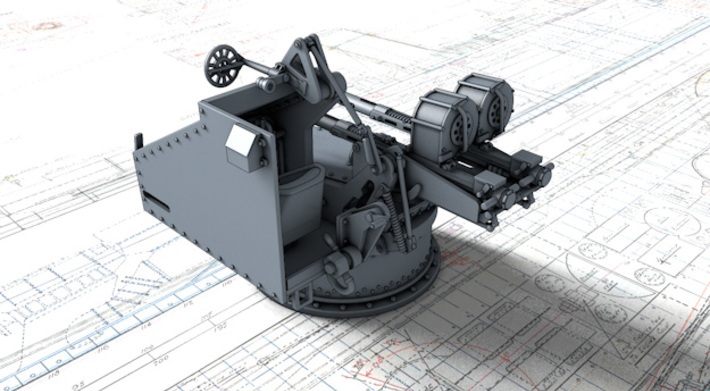 |
| Rear view of the Oerlikon . (Image
via Shipways.com) |
Fourty six Mk VII depth charges were
carried in total and launched by either of two MK IV depth charge launchers.
The launchers were situated on the port and starboard sides of the aft
superstructure. There was also a single, six charge rail on the stern.
In the Royal Navy, the Mk VII launcher was also known
as the 'D' type.
Quantity carried: 22 on deck; 24 between decks.
Weight for Mk VII: 410 pounds
High explosive charge: 396 pounds
Sink rate: 16.5 feet per second
Fuse settings: Depths of 50 to 600 feet.
Fuse type: Hydrostatic.
Comment: Replaced by Squid bombs.
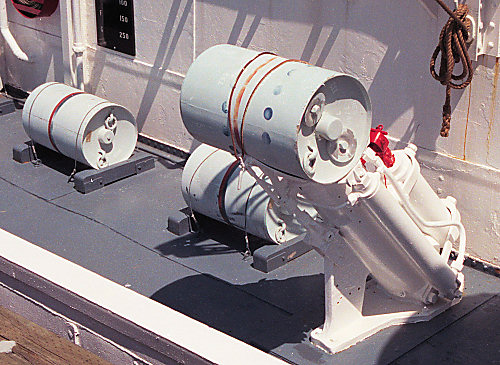 |
| Depth charge thrower. This example is similar to the Mark IV thrower
which was fitted to HAIDA on-build. (Photo by Jerry Proc) |
 |
| It took several crew to load a depth charge.
Here, a Mk VII depth charge is being loaded unto a Mk IV depth charge thrower
aboard the Flower class corvette HMS Dianthus. (Photo via <rebellionresearch.com> |
The K-gun, standardized in 1942, replaced the Y-gun as the
primary depth charge projector (launcher). A WWII era launcher, using a
propellant charge, could hurl a depth charge out to 45 yards. The
K-guns fired one depth charge at a time and could be mounted on the periphery
of a ship's deck, thus freeing valuable centerline space.
If a ship was in imminent danger of sinking as a result
of enemy fire, it was a crewmember's job to disarm all the pistols on the
ready-use depth charges so they wouldn't explode when the sinking ship
passed through the minimum depth setting on the pistol. The percussion
wave generated by a nearby exploding depth charge could crush a sailor's
chest if they were in the water. Later in the war, sailor's
were issued a different style of lifejacket that would protect them from
this danger.
By 1947, HAIDA only carried 10 depth charges on deck, Four were positioned
in the stern launching rail and three for each thrower. No depth charges
were stored between decks.
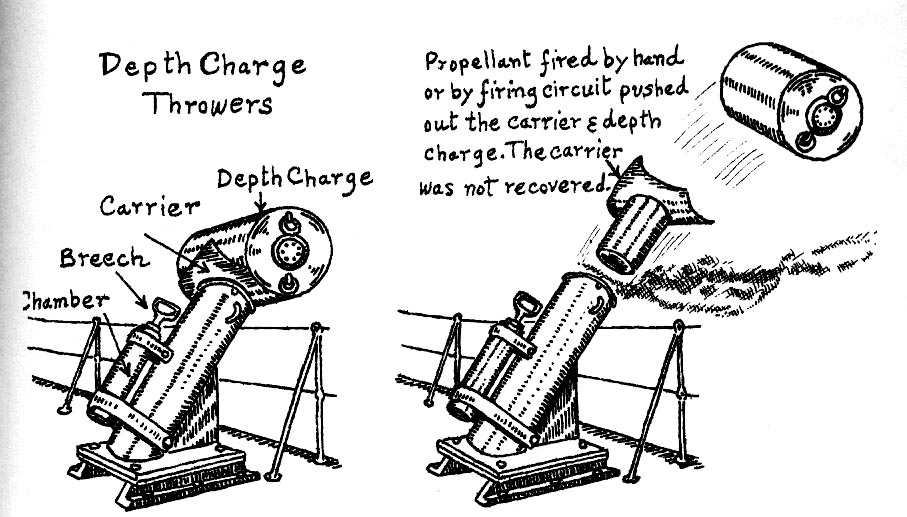 |
| This pictorial shows the launching of a depth charge. Click on image
to enlarge. The gas produced by the propellant pushed on and ejects the
carrier which is not retrieved. propellant charge is inserted into
the chamber by opening the breech. (Sketch by Latham Jenson) |
|
 |
| Principal parts of a depth charge. Click
on image to enlarge. (Sketch by Latham Jenson) |
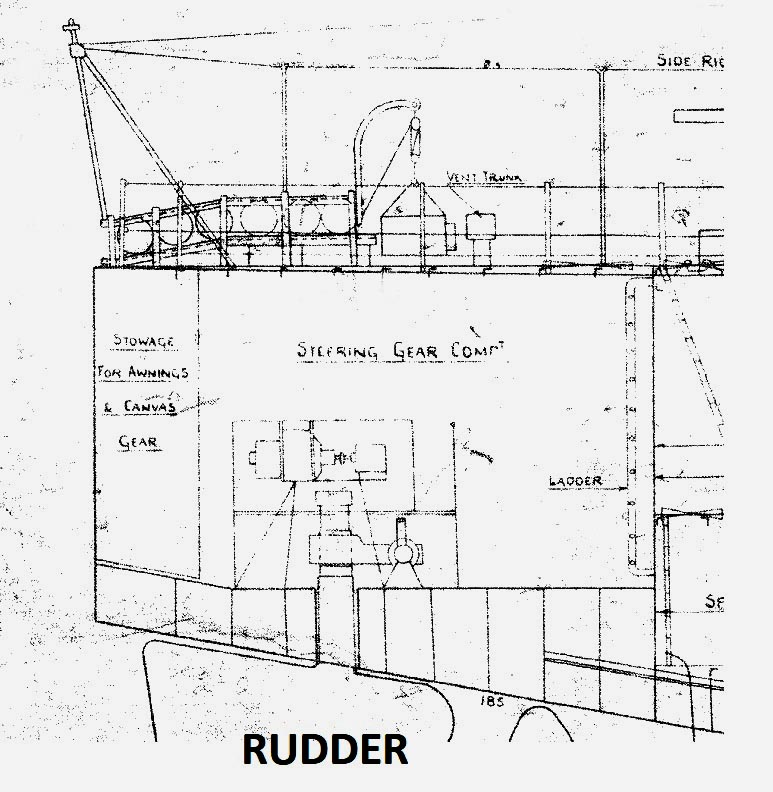 |
| This extract from HAIDA's 1943 deck plans,
show how the on-deck depth charges were stored and rolled off the
rails on the stern of the ship. Note the depth charge hoist on the right
side of the rails. (Provided by Darren Scannell) |
All the Triibals were fitted with the type U2 illumination
rocket prior to Korea . It is believed that the rocket launchers were removed
after the Korean conflict was over.There were no replacements for these.
 |
| This extract from a Tribal plan shows the placement of the rocket
launcher on the starboard side of 'B' gun. Click on image to enlarge. (Provided
by Darren Scannell ) |
 |
| The rocket launchers fitted aboard the Tribals
were nearly identical to this example fitted to HMCS Sackville. On the
Tribal launchers, an additional stiffener strip was added to
the outside vertical centre. (Photo by Jerry Proc) |
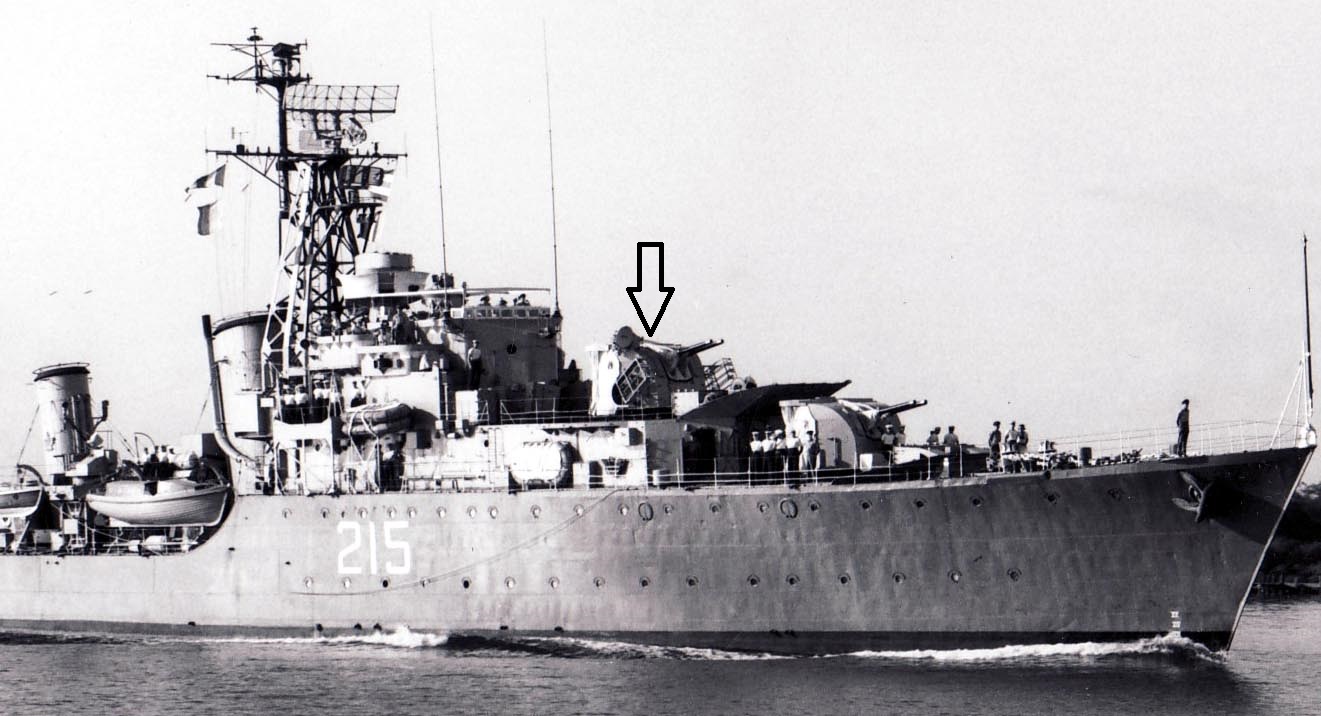 |
| HAIDA in either January or July, 1953. The arrow points to the rocket
launcher. Click on image to enlarge. (Photo 80-G1078441) |
The date ranges for small arms are not all known at this
time.
1) One, Vickers .303 caliber , gas operated machine
gun. (1943 to ?)
Magazine capacity: 96 rounds
Weight: 21 pounds
Rate of fire: 1,000 rounds per minute
Maximum effective range: 440 yards
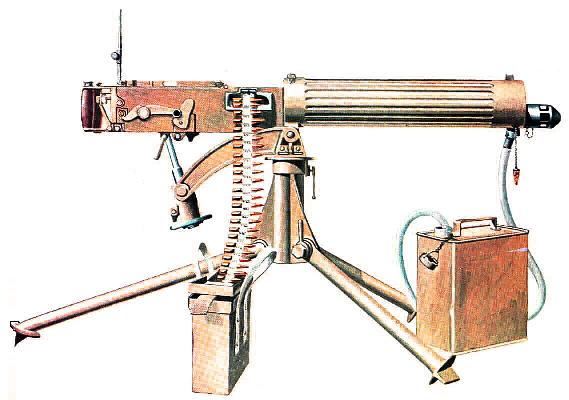 |
| Vickers .303 machine gun. The weapon carried aboard HAIDA would
likely have been grey in colour. (Via Canadiansoldiers.com) |
2) Two BREN light machine guns .303 caliber.
(1943 to ?)
Magazine capacity: 30 rounds.
Weight: 22 pounds
Rate of fire: 500 rounds per minute.
Effective range 880 yards.
Maximum range: 3,300 yards.
 |
| BREN gun . (Photo by Robert
DuHame) |
3) Twenty six Lamchester submachine guns . The
Lanchester is classed as an SMG which means SubMachine Gun. It employs
automatically fed, handgun calibre cartridges. (1943 to ?)
Calibre: 9mm
Rate of fire: 600 rounds per minute
Effective range: 492 feet
 |
| Lanchester machine gun. (Photo by
Fab-pe at Portuguese Wikipedia) |
4) Thirty two, LEE ENFIELD
No.1 Mk III rifles 303. calibre. (1943 to 1963)
There were several racks of these (6 to a rack) .
HAIDA's 1943 drawing shows one rack of rifles located on
the flats against the Officers Galley bulkhead and another rack in the
Reg Office flatsnext to the Egineers Office. Pat Barnhouse, who served
aboard HAIDA in the late 1950s, indicates that the 303 rifles were stored
in a lock up rack just aft of the Officers showers in the after canopy.
Pat seems to remember that the space for these firearms was created during
the 1959 refit. From other ships of HAIDA's era, Pat recalls
rifles being stored on racks in passageways. The quantity of rifles issued
to HAIDA were enough to outfit a decent sized shore party. It was
indicated by a fomer crew member on HMCS Cayuga that the Lee Enfield
.303 would "split your lip if you didnít hold it in tight! "
Effective firing range: 550 yards
Magazine capacity: 5-rounds
Comment: Often referred to as SMLE which is a Short Magazine
Lee Enfield. The acronym also refers to any of a series of bolt action
rifles used by British and Commonwealth Forces during the first half of
the 20th century. It was normally made in .303 calibre..
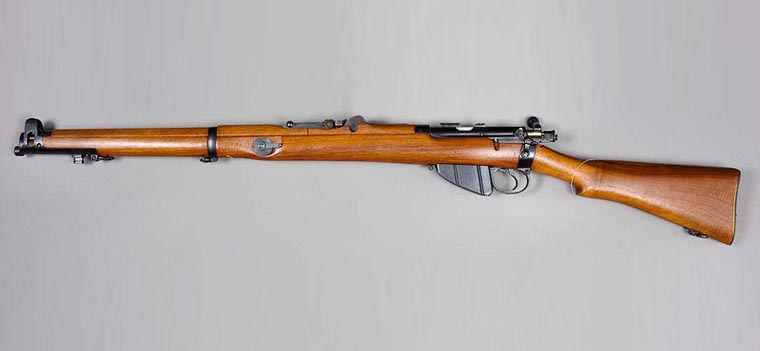 |
| Lee Enfield .303 caliber, bolt action
rifle. (Courtesy Week Magazine) |
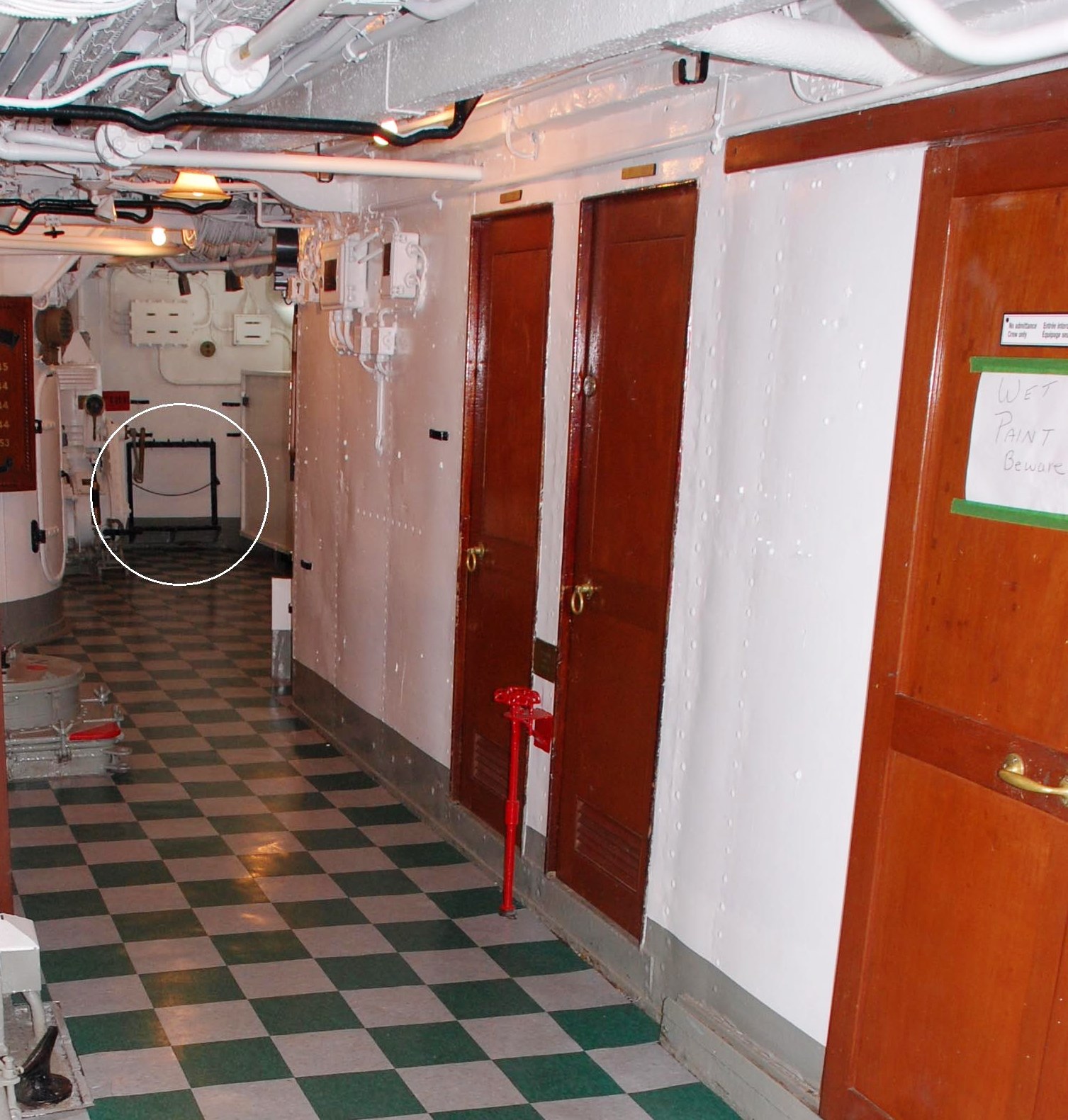 |
| The circled item is the 303 rifle rack in the vicinity of the Officer's
shower. Up to around 2005, this rack had a full complement of rifles
but they were removed and placed into storage. (Photo by Jerry
Proc) |
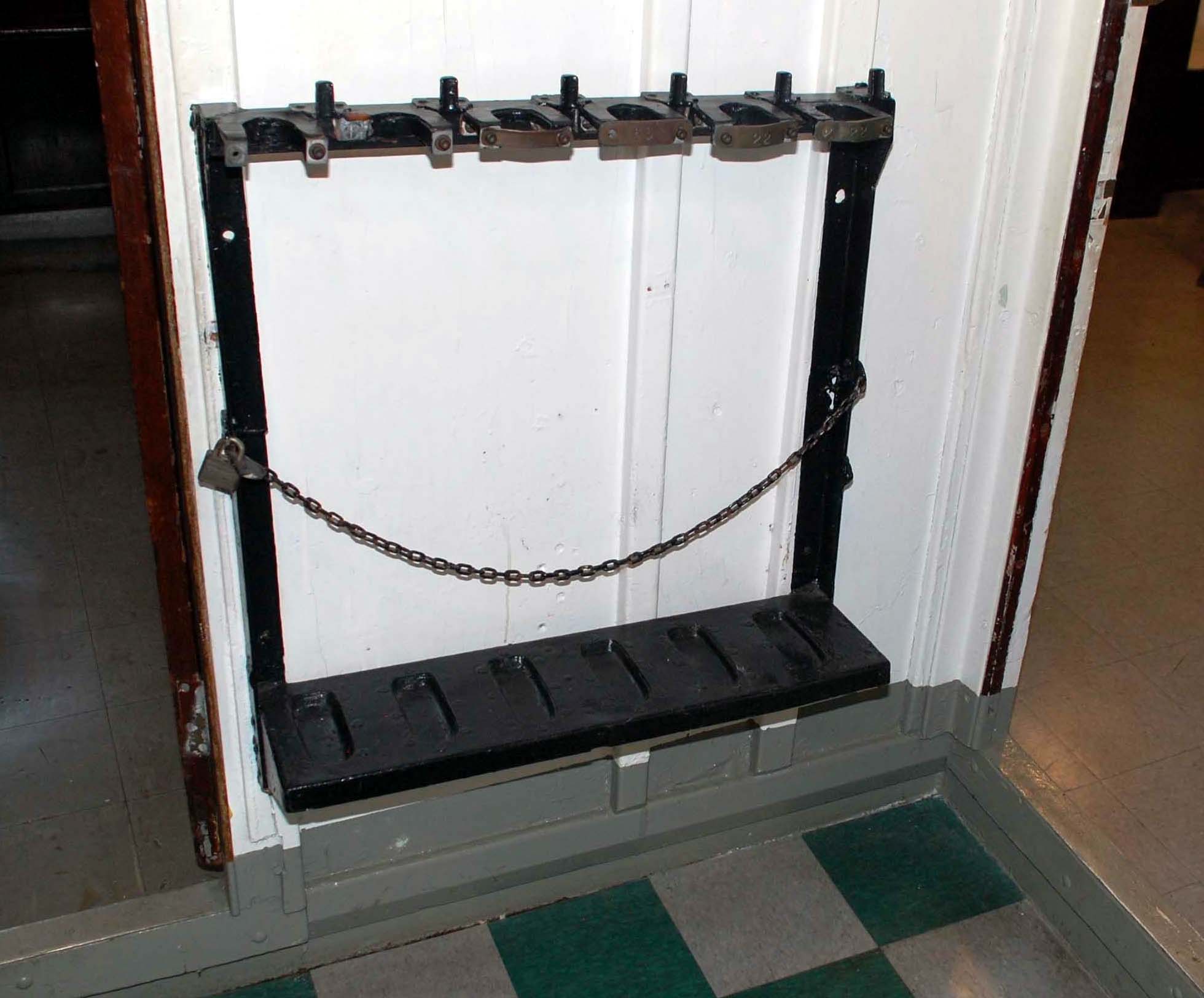 |
| A closer view of the riffle rack. |
The Royal Canadian Navy used a converted Canadian-made
Lee-Enfield rifle to pass lines to other vessels at sea. The rifle fired
a special cartridge to launch a rod with a loop at its end. The rod carried
with it a lightweight line. Sailors on the receiving ship used this to
haul over a heavier line that could then be used to refuel at sea or perform
a jackstay transfer using a special harness. Line throwing rifles could
also be used to establish lines for rescue or salvage work. At this time
it is not known how may of these rifles were carried aboard HAIDA.
 |
| A Line Throwing Lee-Enfield .303 rifle. Click
on image to enlarge. Note that the rod with the loop at the end has already
been inserted into the barrel. When the trigger was pulled, the rod
would be propelled out of the barrel by the gas produced by a blank 303
cartridge. What is missing is the basket which hold the supply of rope.
It would be mounted on the forward , underneath part of the stock.(Canadian
War Museum photo 19700162 001 ) |
PISTOLS - A pistol is a short firearm intended to
be held and fired with one hand.
5) Four .22 caliber rim fire rifles. These were Lee
Enfields, same as the .303 but fitted with a .22 caliber barrel.
6) Twelve revolvers (1943 to ? ) . Make and model
unknown at this time.
7) Five No 1 Mk II Very Pistols (not a weapon)
A Very pistol or signal pistol, is a large-bore handgun that discharges
flares. The flare is used to create illumination for improved vision or
as a distress signal. A flare gun can be used as a deadly weapon; however,
that is not its intended function.
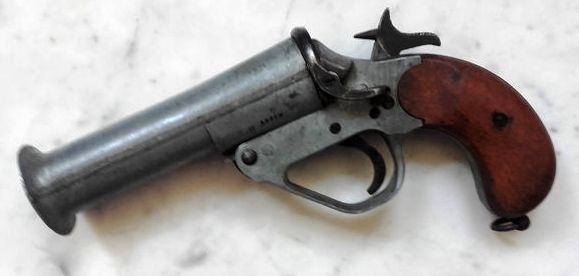 |
| Very pistol No 1 Mk II. (Catawiki
web page) |
8) BROWNING 9 mm ( 1950s to 1963)
In one of the cabinets in the Wardroom, there is evidence that
two rows of 9 mm Browning pistols were stored there since the security
lockup chain is still visible. . Browning's were standard issue in
the Canadian Forces for years. Pat Barnhouse, who served in HAIDA, recalls
that one Browning had Chinese script on it, part of an order that was initially
destined for Nationalist China, but never got there.
Quantity carried: not known at this time.
Maximum clip capacity: 13 rounds
Effective range: 50 meters
Caliber: 9 mm
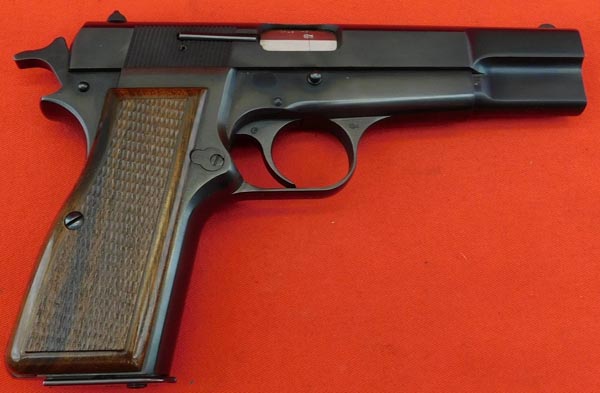 |
| Browning 9 mm pistol. This is the old
style with a small safety only on the left side. When the Browning
first came out, there were no Mark numbers. The Mk II model introduced
in the 1980s, came with an ambidextrous safety. (Photo by
Neil Bell) |
Contributors: or Credits
1) Battle Ensign Flying . Barry Gough. Vanwell
Publishing 2001
2) Vickers 303 https://www.canadiansoldiers.com/weapons/lightweapons/machineguns/vickersmachinegun.htm
3) Two pounder image: https://en.wikipedia.org/wiki/QF_2-pounder_naval_gun#/media/File:HMAS_Nizam_AWM-009496.jpg
4) Twin 4.7 inch mounts. https://commons.wikimedia.org/wiki/Category:QF_4.7_inch_Mk_IX_Mk_XII_naval_gun#/media/
File:HMAS_Napier_guns_SLV_Green_1945.jpg
5) OERLIKON sketch https://www.shapeways.com/product/JYPATWUSY/1-25-royal-navy-twin-20mm-oerlikon-mkix-x1
6) Darren Scannell
7) BREN Gun By I, Robert DuHamel, CC BY-SA 3.0, https://commons.wikimedia.org/w/index.php?curid=2253988)89)
Lanchester photo https://en.wikipedia.org/wiki/Lanchester_submachine_gun#/media/File:Lanchester5.jpg
8) Very Pistol https://www.catawiki.com/l/20426025-ww-ii-era-british-webley-scott-no-1-mk2-flare-gun-26-mm
9) https://en.wikipedia.org/wiki/Depth_charge#Delivery_mechanisms
10) Very pistol. https://en.wikipedia.org/wiki/Flare_gun
11) Oerlikon rear view https://www.shapeways.com/product/BS7CHALQ9/1-48-twin-20mm-oerlikon-powered-mkv-mount
12) Oerlikon front view https://www.shapeways.com/product/KKDB36UEX/1-48-twin-20mm-oerlikon-mkv-mount-not-in-use
13) Depth charge thrower pictorial from "Tin Hats,
Oilskins and Seaboots by LAtham Jenson.Robin Brass Studio NY.NY. 2000
14) Line Throwing Gun 19700162 001 https://www.warmuseum.ca/collections/artifact/1046831/?media_irn=5397611
Back to Tour Intro
Nov 6/20











